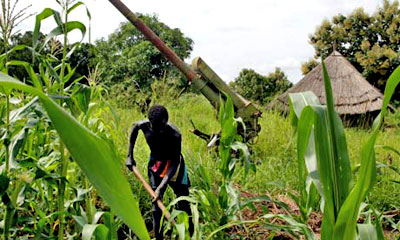|

by Damian Carrington
24 August 2011
from
TheGuardian Website

El Niņo and war - war
between the SPLA and Sudan government
Cyclical climatic changes such have been linked to civil conflict.
A South Sudanese man
works on his farm next to an anti-aircraft gun
destroyed during the
1998 war.
Photograph: Antony
Njuguna/Reuters
Cyclical climatic changes double the
risk of civil wars, with analysis showing that 50 of 250 conflicts
between 1950 and 2004 were triggered by the El Niņo cycle, according
to scientists.
Researchers connected the climate phenomenon known as
El Niņo, which
brings hot and dry conditions to tropical nations and
cuts food
production, to outbreaks of violence in countries from southern
Sudan to Indonesia and Peru.
Solomon Hsiang, who led the research at Columbia University,
New York, said:
"We can speculate that a long-ago
Egyptian dynasty was overthrown during a drought. This study
shows a systematic pattern of global climate affecting conflict
right now. We are still dependent on climate to a very large
extent."
Hsiang said that pre-emptive action
could prevent bloodshed because El Niņo events could be predicted up
to two years ahead.
"We hope our study may help reduce
humanitarian suffering."
Global warming caused by humans, with
the continual ramping up of temperature and extreme weather, differs
from the natural El Niņo cycle, the scientists are careful to note.
Mark Cane, a member of the team, said global warming would
have greater climatic impacts than El Niņo, making it "hard to
imagine" it would not
provoke conflicts.
The scientists are beginning work to discover the factors involved
in the climate-conflict link. Food is likely to be key as crop
yields and incomes from agriculture are known to fall heavily in El
Niņo years. "When crops fail, people may take up a gun to make a
living," said Hsiang.
Other factors could include rises in unemployment and natural
disasters, such as hurricanes.
"Also, previous work has shown that
when people get warm and uncomfortable, they are more prone to
fight,"
said Cane.
The
research, published in Nature, uses
a statistical approach to show that the risk of a conflict doubles
from 3% to 6% in El Niņo cycles (which occur every three to seven
years) in affected nations. Unaffected nations showed no such
pattern.
The analysis shows that a fifth of the 250 civil conflicts between
1950 and 2004 were precipitated by hotter, drier weather. Differing
levels of poverty, democracy and population did not alter the
strength of the climate-conflict link, nor did the impact of the end
of colonial rule in many countries by 1975.
However, bad weather does appear to tip less developed countries
into chaos more easily, said Hsiang, pointing to the example of
southern Sudan, where intense warfare broke out in the El Niņo year
of 1963.
After a flare-up in another El Niņo year, 1976, a severe El Niņo, in
1983, saw the start of more than 20 years of fighting, which left 2
million people dead and culminated only this year when
South Sudan
was formed as a separate nation.
By contrast, Australia's climate is controlled by El Niņo cycles,
but has had no civil conflicts.
"One hypothesis is the poorest
countries lack the resources to cope with [the impacts] of El
Niņo," said Hsiang. "Another is that they could be physically
more vulnerable to El Niņo, prompting war and leading to
poverty."
Marshall Burke, an economist at
the University of California, Berkeley, said the research gave very
convincing evidence of a connection.
Andrew Solow, an environmental
statistician, at the Woods Hole Oceanographic Institution, said:
"Careful statistical analyses such
as this one, which relate complex human behaviour to
environmental factors, can be invaluable."
Yaneer Bar-Yam, president of the
New England Complex Systems Institute in the US, said:
"It is part of the progress we are
making in understanding the drivers of human social behavior."
|

